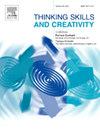东亚学生的创造性思维:课外活动和支持性环境的作用
IF 4.5
2区 教育学
Q1 Social Sciences
引用次数: 0
摘要
创造性思维越来越被认为是学术和终身成功的关键能力。根据来自亚洲四小龙——新加坡、中国香港、韩国和中国台北的16,893名学生的数据,本研究调查了课外活动和支持性环境对东亚学生创造性思维的直接和间接影响。结构方程模型的结果表明,学校活动,特别是那些强调表达和STEM领域的活动,通过增强内在动机、好奇心和冒险倾向,积极地预测创造性思维。相比之下,类似领域的校外活动往往与创造性思维负相关,可归因于商业化、证书主义和性能驱动的设计。学校和教学支持显示出复杂的影响:虽然通过个人特征产生间接的好处,但直接的联系往往是负面的,反映了以创造力为导向的教学法与以考试为中心、等级森严的学校文化之间的紧张关系,以及创造性教学的肤浅实施。同伴和家庭的支持不断地促进创造性思维,直接或通过个人特质。本研究扩展了Amabile的内在动机假说和Sternberg和Lubart的投资理论,强调了自主支持环境在培养创造性思维方面的重要性,这种环境优先考虑开放式、非工具性学习,而不是评估驱动的约束。本文章由计算机程序翻译,如有差异,请以英文原文为准。
Student creative thinking in East Asia: The role of extracurricular activities and supportive environments
Creative thinking is increasingly recognized as a critical competency for academic and lifelong success. Drawing on data from 16,893 students in the Four Asian Tigers—Singapore, Hong Kong-China, South Korea, and Chinese Taipei—this study investigates the direct and indirect effects of extracurricular activities and supportive environments on East Asian students’ creative thinking. Results from structural equation modeling reveals that in-school activities, particularly those emphasizing expression and STEM domains, positively predict creative thinking via enhanced intrinsic motivation, curiosity, and risk-taking propensity. In contrast, out-of-school activities in similar domains often are often negatively associated with creative thinking, attributable to commercialization, credentialism, and performance-driven design. School and instructional support demonstrates complex effects: while indirect benefits emerge via individual traits, direct associations are often negative, reflecting tensions between creativity-oriented pedagogy and test-centric, hierarchical schooling cultures, as well as the superficial implementation of creative instruction. Peer and family support consistently promote creative thinking both directly and through individual traits. Extending Amabile’s intrinsic motivation hypothesis and Sternberg and Lubart’s investment theory, this study highlights the importance of autonomy-supportive environments that prioritize open-ended, non-instrumental learning over assessment-driven constraints in fostering creative thinking.
求助全文
通过发布文献求助,成功后即可免费获取论文全文。
去求助
来源期刊

Thinking Skills and Creativity
EDUCATION & EDUCATIONAL RESEARCH-
CiteScore
6.40
自引率
16.20%
发文量
172
审稿时长
76 days
期刊介绍:
Thinking Skills and Creativity is a new journal providing a peer-reviewed forum for communication and debate for the community of researchers interested in teaching for thinking and creativity. Papers may represent a variety of theoretical perspectives and methodological approaches and may relate to any age level in a diversity of settings: formal and informal, education and work-based.
 求助内容:
求助内容: 应助结果提醒方式:
应助结果提醒方式:


